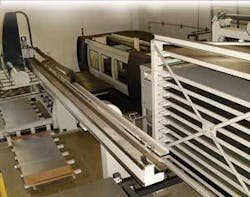Automation: a revolution for the laser world
Automation systems combine material storage and laser cutting for greater efficiency in the workplace
Laureen J. Belleville
The combination of a programmable material storage system and fully automated laser cutting enables companies to increase efficiency and reduce costs while adding capacity and increasing scheduling efficiencies. Raw material can be inventoried in a tower and retrieved automatically for processing. The ability of these systems to operate unattended further enables just-in-time (JIT) production.
“The automation system has revolutionized the way we’re managing our business with regards to a zero setup mentality; we are JIT,” reports Brad Severson, president of Lake Air Metal Products (Minneapolis, MN; www.lakeairmetals.com). His company, a precision metal fabricator for industries such as medical, aerospace, and conveyor and feed systems, uses a 4000W Axel CO2 laser cutting machine with a 26-shelf tower (both from Strippit/LVD, Akron, NY; www.lvdgroup.com)with three load stations for automated sheet load/unload. “My lead times have been reduced significantly for any work that can go through the laser system.”
He notes that more of the company’s work is now lower volume with reduced lead times. “The key to this game is to reduce your setup,” Severson says. “If you can get it to zero, it allows you to run small lots, which helps to increase inventory turns and free up valuable floor space because you’re not inventorying finished goods.” He claims that if a job is strictly done on the laser, he can get a job in on Thursday afternoon and have the product out Friday morning.
Michael Gibb, vice president of Wrayco Industries Inc. (Stow, OH; www.wrayco.com), a company that supplies fabrication for the construction industry, agrees with Severson. “We supply our customers on a JIT inventory basis,” he says. “We are ‘lasering’ about 36 hours before we plan on shipping. We laser, punch, form, fit, weld, grind, test, and paint within a 24-hour period.” His company runs two 4000W Axel laser systems with automated load/unload tied into the LVD tower system, which has 28 storage locations for different types of steel.
Twenty years ago, companies like these typically would process a product for three to five years. Now, products are run from three to five months. Shorter lead times and limited product life are the way of the future. One-day lot sizes are becoming more commonplace. Quick-turn laser work means that parts can be run overnight. For both companies, second shifts and weekend work are driven by the laser; and automation allows the systems to run unmanned. The towers also give users the flexibility to store and use different material and different material thicknesses-alternately processing 5mm, 10mm, and 4mm material with relative ease. Additionally, Wrayco, for example, uses its tower system to store remnants. “If we don’t need to process a complete sheet of 5mm material, maybe we only need half a sheet, we’ll cut that sheet in half and store the other half in the tower system until we need to come back to it-maybe later that day or the next day,” explains Gibb. In the near future, the company expects to begin producing and shipping 100 backhoe tanks per day for various customers.
Staying competitive in their respective industries is a driving factor for both companies. “We’re able to compete on a global basis through this zero-setup, high-productivity, quick-turn environment,” notes Severson. He boasts that for virtually 84 percent of a 24-hour day his machine resonator is in the ‘go’ position. The biggest problem he has encountered is figuring out what to do with all the parts he produces-a 33 percent increase in throughput with one laser. In fact, he has one full-time employee on every shift simply to manage materials in and materials out and has acquired two press brakes to manage the work coming off the laser. “I’ve added six employees with a 20 percent revenue increase,” he claims.
In addition to sheet utilization, Wrayco focuses on efficiency with its two lasers and tower system. Automation has made a huge impact here, according to Gibb: he says it’s the automation throughout the system that separates Wrayco from its competition. The same two lasers it used when it was doing $18 million worth of work are now on track to do $35 million worth of work, with no capital investment. “The same two operators I had operating my lasers that I had three years ago at $18 million in sales are the same two operators per shift that I have at $35 million. By increasing how efficiently we run a machine, we’re able to support the increased work and still have at least 20 percent open capacity on those lasers.” Wrayco currently occupies 148,000 square feet and is in the process of completing a 150,000-sq.ft. addition.
Without solid software and programming considerations, users would have a hard time reaping the benefits of automation. With its twin towers, 12 and 14 shelves respectively, there’s a constant movement of material at Lake Air Metal Products. The key to keeping things running is the software. “Our software automates the whole process,” explains Severson. “It looks at the work available, segregates that work by material, goes into my engineering files to pull dxf files, does the nesting automatically, and presents that opportunity to us. If we say yes, we just hit the ‘go’ button.” Better material utilization-about 10 percent-is the result. “As much material as we run,” notes Severson, “that’s a significant dollar amount.”
Both Gibb and Severson have only praise for their laser/automation systems. Says Gibb, “Without the lasers, I don’t know how we would meet daily demand. It is just amazing what they produce in a day.” Severson agrees that it was important for his company to take the ‘next step’ in automation with the laser: “Without it, our business would have to go in a different direction-and that wouldn’t necessarily be forward.”


